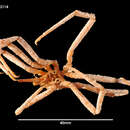en
names in breadcrumbs


“Ammothea longispina n. sp. (Figs. 50b, 51 and 52).
St. 170. 23. ii. 27. Off Cape Bowles, Clarence Island, 61°25’30”S, 53°46’W, 342 m.; R. Large dredge: 1 female (holotype).
Description of holotype. Trunk rather compact; lateral processes separated by narrow intervals, last two pairs by almost their own diameter. Transverse body ridges prominent, each with a narrow, conical median projection. Cephalic segment with a blunt rounded lobe external to the insertion of each chelophore; hardly as long as the sum of the two succeeding segments. Ocular tubercle rather higher than wide, stout, rounded at apex; eyes set near apex, of small size but the anterior rather larger than the posterior pair (Fig. 51).
Proboscis longer than trunk, straight, slender; widest in proximal third narrowing to almost half this width anteriorly; apparently suited for probing.
Abdomen rather long but much elevated, so that it does not reach beyond the distal end of the fourth lateral process.
Chelophore almost one-third of proboscis; scape twice as long as wide distally; chela small, fingers almost obsolete.
Palp much shorter than proboscis, with only eight segments; second subequal to fourth segment (Figs. 51 and 52a).
Oviger as represented in Fig. 52b.
Third leg rather short and stout. Second coxa approximately equal to the sum of the first and third. Femur five times as long as wide, slightly shorter than second tibia. Terminal segments as represented in Fig. 50b; distal spine on propodus unusually large, the smaller spine wanting on the propodus of the first leg.
Setules on trunk restricted to the conical process of each transverse ridge, the two low cephalic protuberances and the distal border of each lateral process. On the legs they are arranged in longitudinal rows on the longer segments; on the dorsal border of each tibia they are replaced by small, curved spines.
Measurements (mm).
Length of proboscis
13.3
Greatest width of proboscis
2.4
Length of trunk
11.6
Length of cephalic segment
4.9
Width of anterior border of cephalon
3.9
Width across second lateral processes
10.0
Length of abdomen
5.6
Length of chelophore
4.0
Third leg:
First coxa
2.8
Second coxa
4.6
Third coxa
2.0
Femur
14.0
First tibia
12.2
Second tibia
15.0
Tarsus and propodus
4.8
Claw
2.8
Auxiliaries
0.8
Remarks. Each palp seems to be quite perfect and there is no distinct evidence of fusion of any two segments. This species is much larger than A. tetrapora and is characterized by (1) the long, tapering proboscis, (2) the relatively short palp (in A. tetrapora the palp is longer than the proboscis), (3) the very large spine on the propodus, and (4) the blunt antero-lateral cephalic lobes.” (Gordon 1932, p.101-103)